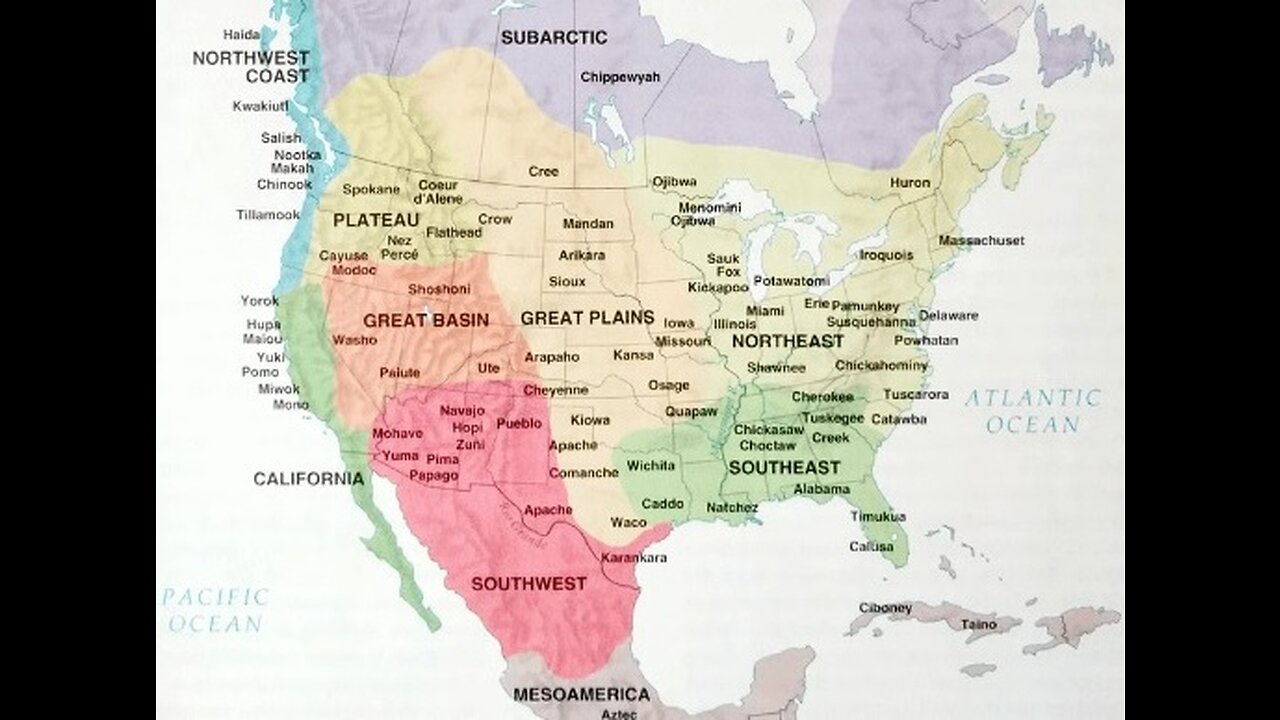Premium Only Content

Black People-Indigenous Tribes In North America 1,000's Years Before Columbus True
Ancient Africans Discovered America Thousands Of Years Ago? Contrary to popular belief, African American history did not start with slavery in the New World. An overwhelming body of new evidence is emerging which proves that Africans had frequently sailed across the Atlantic to the Americas, thousands of years before Columbus and indeed before the Vikings. The great ancient civilizations of Egypt and West Africa traveled to the Americas, contributing immensely to early American civilization by importing the art of pyramid building, political systems and religious practices as well as mathematics, writing and a sophisticated calendar.
The strongest evidence of African presence in America before Columbus comes from the pen of Columbus himself. In 1920, a renowned American historian and linguist, Leo Weiner of Harvard University, in his book, Africa and the discovery of America, explained how Columbus noted in his journal that Native Americans had confirmed that “black skinned people had come from the south-east in boats, trading in gold-tipped spears.” Located in the Museum of the Seminary of Sherbrooke in Quebec, Canada there are a set of mysterious stones that, according to many who have researched them, could offer conclusive evidence that neither the Vikings, nor Columbus traveled to America first, but a culture from Northern Africa 2,500 years ago.
The stones have been in the museum since at least 1910, but they were discovered much earlier. The two flat stone pieces of limestone are three feet long and one and a half feet high and weigh around four hundred pounds. They were discovered in a field near the St Francois River by M. Ludger Soucy sometime early in this century.
At the time of the discovery the considerably weathered stones were covered with two lines of unknown script.
Professor Thomas Lee, a Laval University archaeologist deciphered the inscriptions. According to Professor Lee the Egyptian inscriptions were written in a Libyan script. Professor Lee said: “The Libyans would have been operating, in my opinion, out of Carthage, which was a Phoenician city at the time”.
He added saying the inscriptions suggest an ancient expedition reached the area after sailing up the St. Francis River, which flows into the St. Lawrence River, southwest of Trois-Rivieres, Quebec.
Native American Tribes Map: Indigenous Peoples USA The map above shows how indigenous American tribes were distributed throughout North America and parts of the Caribbean.
These indigenous peoples (IPs), with 86 tribes in total, are spread in 11 regions throughout the continent.
The Eskimo is the sole tribe in the Arctic region, located in the extreme north of present-day Canada and the Danish province of Greenland.
Two indigenous groups occupy the Subarctic region that comprises most of north-central Canada:
Yellowknife - Chippewyah
Eight IP groups live in the Northwest Coast region:
Tlingit - Haida - Kwakiutl - Salish - Nootka - Makah - Chinook - Tillamook
In the California region live seven tribes:
Yorok - Hupa - Maiou - Yuki - Pomo - Miwok - Mono
Five ethnic groups inhabit the Plateau area:
Spokane - Coeur d’Alene - Cayuse - Nez Perce - Flathead
There are also five IP groups living in the Great Basin area:
Modoc - Shoshoni - Washo - Paiute - Ute
The Southwest region houses ten groups:
Navajo - Apache - Hopi - Zuñi - Mohave - Yuma - Pima - Papago - Pueblo - Karankara
In the region of Mesoamerica live three ethnic tribes:
Aztec - Ciboney - Taino
There are 16 tribes living in the Great Plains region:
Cree - Crow - Mandan - Arikara - Sioux - Iowa - Missouri - Arapaho - Kansa - Osage - Cheyenne - Quapaw - Kiowa - Apache - Comanche - Waco
In the Northeast region live the most number of indigenous tribes, 19 to be exact:
Ojibwa - Huron - Menomini Ojibwa - Saux Fox - Iroquis - Massachuset - Kickapoo - Potawatomi - Illinois - Miami - Erie - Pamunkey - Susquehanna - Delaware - Powhatan - Shawnee - Chickahominy - Tuscarora - Catawba
Finally, in the Southeast region live 11 indigenous American tribes:
Cherokee - Tuskegee - Creek - Chickasaw - Choctaw - Wichita - Caddo - Natchez - Alabama - Timukua - Calusa
In this Reddit thread, several users notice that since the map is sourced from a textbook published in the United States (US), there are more tribes situated in the modern-day US. This means that other nations such as Canada and Mexico are underrepresented, and only have a few tribes listed on the map.
BLACK CIVILIZATIONS OF ANCIENT AMERICA (MUU-LAN), MEXICO (XI) Gigantic stone head of Negritic African during the Olmec (Xi) Civilization.
The earliest people in the Americas were people of the Negritic African race, who entered the Americas perhaps as early as 100,000 years ago, by way of the bering straight and about thirty thousand years ago in a worldwide maritime undertaking that included journeys from the then wet and lake filled Sahara towards the Indian Ocean and the Pacific, and from West Africa across the Atlantic Ocean towards the Americas.
According to the Gladwin Thesis, this ancient journey occurred, particularly about 75,000 years ago and included Black Pygmies, Black Negritic peoples and Black Australoids similar to the Aboriginal Black people of Australia and parts of Asia, including India.
Recent discoveries in the field of linguistics and other methods have shown without a doubt, that the ancient Olmecs of Mexico, known as the Xi People, came originally from West Africa and were of the Mende African ethnic stock. According to Clyde A. Winters and other writers (see Clyde A. Winters website), the Mende script was discovered on some of the ancient Olmec monuments of Mexico and were found to be identical to the very same script used by the Mende people of West Africa. Although the carbon fourteen testing date for the presence of the Black Olmecs or Xi People is about 1500 B.C., journies to the Mexico and the Southern United States may have come from West Africa much earlier, particularly around five thousand years before Christ. That conclusion is based on the finding of an African native cotton that was discovered in North America. It's only possible manner of arriving where it was found had to have been through human hands. At that period in West African history and even before, civilization was in full bloom in the Western Sahara in what is today Mauritania. One of Africa's earliest civilizations, the Zingh Empire, existed and may have lived in what was a lake filled, wet and fertile Sahara, where ships criss-crossed from place to place.
The earliest trade and commercial activities between prehistoric and ancient Africa and the Americas may have occurred from West Africa and may have included shipping and travel across the Atlantic. The history of West Africa has never been properly researched. Yet, there is ample evidence to show that West Africa of 1500 B.C. was at a level of civilization approaching that of ancient Egypt and Nubia-Kush. In fact, there were similarities between the cultures of Nubia and West Africa, even to the very similarities between the smaller scaled hard brick clay burial pyramids built for West African Kings at Kukia in pre Christian Ghana and their counterparts in Nubia, Egypt and Meso-America.
Although West Africa is not commonly known for having a culture of pyramid-building, such a culture existed although pyramids were created for the burial of kings and were made of hardened brick. This style of pyramid building was closer to what was built by the Olmecs in Mexico when the first Olmec pyramids were built. In fact, they were not built of stone, but of hardened clay and compact earth.
Still, even though we don't see pyramids of stone rising above the ground in West Africa, similar to those of Egypt, Nubia or Mexico, or massive abilisks, collosal monuments and structures of Nubian and Khemitic or Meso-American civilization. The fact remains, they did exist in West Africa on a smaller scale and were transported to the Americas, where conditions such as an environment more hospitable to building and free of detriments such as malaria and the tsetse fly, made it much easier to build on a grander scale.
In many parts of the Americas today, there are still people of African Negritic racial backgrounds who continue to exist either blended into the larger African-Americas population or are parts of separate, indigenous groups living on their own lands with their own unique culture and languages.
One such example is the Washitaw Nation who owned about one million square miles of the former Louisiana Territories, but who now own only about 70,000 acres of all their former territory. The regaining of their lands from the U.S. was a long process which concluded partially in 1991, when they won the right to their lands in a U.S. court.
The Black Californian broke up as a nation during the late 1800's after many years of war with the Spanish invaders of the South West, with Mexico and with the U.S. The blended into the Black population of California and their descendants still exist among the millions of Black Californians of today.
The Black Caribs or Garifunas of the Caribbean Islands and Central America fought with the English and Spanish from the late fifteen hundreds up to 1797, when the British sued for peace. The Garifuna were expelled from their islands but they prospered in Central America where hundreds of thousands live along the coasts today.
The Afro-Darienite is a significant group of pre-historic, pre-columbian Blacks who existed in South America and Central America. These Blacks were the Africans that the Spanish first saw during their exploration of the narrow strip of land between Columbia and Central America and who were described as "slaves of our lord" since the Spaniards and Europeans had the intention of enslaving all Blacks they found in the newly discovered lands.
The above mentioned Blacks of precolumbian origins are not Blacks wo mixed with the Mongoloid Indian population as occurred during the time of slavery. They were Blacks who were in some cases on their lands before the southward migrations of the Mongoloid Native Americans. In many cases, these Blacks had established civilizations in the Americas thousands of years ago.
During the International Congress of American Anthropologists held in Bacelona, Spain in 1964, a French anthropologist pointed out that all that was missing to prove a definite presence of Negritic Blacks in the Americas before Columbus was Negroid skeletons to add to the already found Negroid featured terracottas. Later on February of 1975 skeletons of Negroid people dating to the 1200's were found at a precolumbian grave in the Virgin Islands. Andrei Wierzinski, the Polish crainologist also concluded based on the study of skeletons found in Mexico, that a good portion of the skulls were that of Negritic Blacks,
Based on the many finds for a Black African Negroid presence in ancient Mexico, some of the most enthusiastic proponents of a pre-columbian Black African presence in Mexico are Mexican professionals. They conclude that Africans must have established early important trading centers on the coasts along Vera Cuz, from which Middle America's first civiliztion grew.
In retrospect, ancient Africans did visit the Americas from as early as about 100,000 B.C. where they stayed for tens of thousands of years. By 30,000 B.C., to about 15,000 B.C., a massive migration from the Sahara towards the Indian Ocean and the Pacific in the East occurred from the Sahara. Blacks also migrated Westward across the Atlantic Ocean towards the Americas during that period until the very eve of Columbus' first journey to the Americas.
Trade, commerce and exploration as well as the search for new lands when the Sahara began to dry up later in history was the catalyst that drove the West Africans towards the Atlantic and into the Americas.
The experience of the Washitaw Nation (or Ouchita Nation) of the Southern United States is another piece of solid evidence for the fact of pre-Columbian African presence and settlement in the Americas and specifically in the United States. According to an article carried in the magazine, 'The Freedom Press Newsletter, (Spring, 1996), reprinted from Earthways, The Newsleter of the Sojourner Truth Farm School (August, 1995), the Washitaw were (and still are) a nation of Africans who existed in the Southern U.S. and Mississippi Valley region long before the 16th century Europeans arrived and even before there were "Native Americans" on the lands the Washitaw once occupied and still occupy today.
According to the article, "the Washitaw Nation "governed three million acres of land in Louisiana, Arkansas, Oklahoma, Texas and Mississippi. They were ship builders (similar to the Garifuna of the Caribbean, who are also of pre-Columbian West Afrucan Mandinka Muslim origins (according to Harold Lawrence in 'African Presence in Early America,edt. by Ivan Van Sertima).
What is even more facinating about this aspect of hidden history of Blacks in America before Columbus is that the Washitaw Nation was known and recognized as a separate, independant Black nation by the Spanish and French, who were in the Louisiana Territories and Texas areas. According to the present leader of the Washitaw Nation, "when Spain ceeded the Louisiana Territory to France, they excluded the land belonging to the Washitaw Nation. France did not include it in the "Louisiana Purchase," and according to the leader, "This land
is not part of the United States of America." That point was made in the newspaper, "The Capitol Spotlight, June 1992.
In fact, the courts agreed that the land was not part of the U.S. and that in fact the Washitaw (Ouchita) Nation was on the land long before European Colonization: therefore, in legal decisions made, some of the ancient territory was returned. This historical decision was made about 1991.
This is the type of information seldom seen in the majority press, yet, the importance of that event clearly points to the incredible service small papers and magazines such as Ancient American or the Capitol Spotlight and The Freedom Press Newsletter have been making, along iwth internet news and information sites such as this one. So, here we see an example in the continental United States where Africans who came before slavery, before Columbus and thousands of years before Christ (over six thousand years B.C., according to the Washitaw chroniclers), were engaged in boat building, seafaring, trade and commerce in ancient times and who still exist today as a distinct Black Nation who have evidence and proof of their ownership of millions of acres of lands in the Southern U.S. and the Mississippi Valley. The Washitaw Nation held an important convention in June 1992, in Monroe, Louisiana and have held others since. (Washitaw's point of view on their history and culture).
Yet, the Washitaw is merely one nation of the descendants of pre-columbian Blacks from Africa and elsewhere and possibly from right here in the Americas as the very first people to exist here, long before the development of the Mongoloid, American Indians or the Mongoloid( 15,000 B.C.) or even the Caucasian races (30,000 B.C.). Pure Black Homosapiens began to migrate from Africa and populate the entire earth about 200,000 to 150,000 years ago, according to scientists, historians and anthropologists.
Among the other Black nations who existed in the Americas before Columbus and long before Christ were the Jamassee (Yamassee), who had a large kingdom in the South eastern U.S., Their descendants were among the first Blacks of pre-columbian American origins who fell victim to kidnapping for the purpose of enslavement. Blacks of South America, the Caribbean and Central America were also attacked and enslaved based on a Pontifax passed during the mid- 1400's by the Church hierachy giving the Europeans the go ahead to enslave all "Children of Ham" found in the newly discovered territories. The descendants of the Jamassee are the millions of Blacks who live in Alabama, Gerogia, South Carolina and northern Florida. They of course also have African slave ancestors, but these slaves are the relatives of the same Africans who sailed to America of their own free will, while Europe was in the Dark Ages, and long before Christ, for that matter.
In California, descendnats of the fierce "Black Californians" who were a Negroid people of African racial origins and the original owners of California and the South. Many African-Americans in California are of Black Californian ancestry and their great grand parents were among the original Black Californians who were victims of Spanish Californio enslavement and Anglo American settler attacks. In fact, the Black Californian fought until the late 1800's to maintain control of their ancestral lands from the settlers.
There are aboriginal nations of Blacks in Panama such as the Afro-Darienite and the Choco people.
In fact, the Afro-Darienite are the remnants of the aboriginal Black nations of South and Central America who were once hunted down to be made slaves by the Spaniards (in fact Balboa or Peter Matyr chroniclers referred to these Blacks as "slaves of our lord," ) meaning, like Blacks in Africa, the South Pacific and elsewhere, they were eligible for enslavement, being descended from Ham, the so-called "father of the Black race."
In Columbia's Choco Region, on the Western side of that country, there are hundreds of thousands of Blacks, whose ancestors have been in Columbia for thousands of years. In fact, scientists and some historians have found out that Black slaves were being kidnapped and hunted down in Columbia and parts of South and Central America, as well as the Caribbean and U.S., by the Spaniards and others long before they began to look for slaves in Africa. (an old painting in Natonal Geographic clearly shows a black with bow and arrow and wearing a loin cloth, hunting along the coast of Columbia during the first voyage there by the Spaniards.
These Blacks today of the Choco Region of Columbia are among the most oppressed of Blacks in Latin America today.
Then there is the Garifuna or Kalifunami also called "Black Caribs" Being a member of the Black Carib Nation and having done historical research, the myth of the Black Caribs being escaped slaves has been debunked. It is true that the Black Caribs encouraged slaves from the West Indies Islands to join them and that the Black Caribs did ally with the Mongoloid Caribs of Dominica and other parts of the West Indies, but the fact remains, that the Black Caribs were originally Mende traders of gold and cloth, who established settlements throughout the Circum-Caribbean region, Mexico, Central America, South America and the Southern U.S.
They had been arriving in the Americas for thousands of years, even before they converted to Islam during the 900's A.D.. In fact, the Olmecs of ancient Mexico were Mende, they used the Mende script (found on monments at Monte Alban, Mexico, and they named places from southern Mexico to South America with Mandinka names. Such names sometimes sound identical to the names of places used in West Africa.
In retrospect, while the debate for reparations increses, it is important that African-Americans know that two great injustices were committed by the Europeans. The first was slavery, the second was the taking of Black lands and destroying Black history and culture so Blacks remain totally ignorant of their rights to more than one third of north America.
One of the most important aspects of Black history worldwide is the development of Black civilization due to the early and persisten use and application of trade and commerce. Due to such early and well organized trading and commercial systems throughout the prehistoric Black world, Blacks were able to expand throughout the world and establish the world's first cultures and civilizations. Although it is said that Blacks migrated from the original homeland of mankind in Africa to settle all Asia, Europe, Australia and the Americas (see Scientific American; Sept. 2000, p. 80-87...this is a recent publication), long before the differentiation of the races from the original Negritic to Negriic, Caucasoid, Mongoloid, along with the various mixed races such as Polynesians, Native Americans, Japanese, Malays, Mediterranean whites, East Indians (the mixed Negroid/Caucasian type...not the pure Black pre Aryan Negritic Indians), Arabs, Latinos (Mestizos, Mullatoes, Zambos, Spaniards) and a number of other mixed races and regional types, the purpose of the earlies migrations of Blacks from Africa to the rest of the world was not merely following and hunting wild animals, as some theorists have claimed, but searching for commodities, like red ocre to paint the smooth, dark skin from insects and decoration. Another purpose for the early migrations of Africans to other parts of the world was to establish trading and commercial links to those of their own people, who had left previously. Hence, even if the earliest migrations were after wandering herds of animals, further migrations were in search of links with their kinsmen and women.
The migrations of Africans to all parts of the world within the past hundred thousand years
or more occurred before an other races existed. Thus, Black culture and civilization was being established when no other "races" existed as we know them today. This is a facinating historical even, because having been homosapiens for over one hundred thousand years, it is very possible that Blacks could have gone through many periods of cultural development and civilization before the beginning of the Nile Valley civilization (since about 17,000 B.C.) or the Zingh Civilization of the South-Western Sahara (15,000 B.C.), or even Atlantis (10,000 B.C.), or the building of the Sphinx (7,000 B.C.).
In fact, there is evidence from ancient East Indian chronicles (some of these pictures are on AAWR (African American Web Ring) of the geat scientific advancement of the Black prehistoric inhabitants of the Indus Valley Civilization (6000 b.c. to 1700 b.c), who built flying machines, who had flushing toilets, cities on a gridlike pattern, and many of what we may call "modern" conviniences.
About 20,000 years ago, the present-day dried up and desertified Sahara had an aquatic civilization where the Africans who lived on the edges of the giant inland sea, built large ocean-going ships. Rock paiintings of these ships can still be seen in the Sahara (and some appeared on national geographic magazine about two years ago).
The Africans who used these boats (which are still used today by tribes such as the Baduma of Mali, West Africa) made of papyrus straw. These same type of boats were used to travel to the Americas, the Indian Ocean, the South Pacific, India, East Asia and the Pacific, then to the Americas via the Pacific Ocean. In fact, the Fijians still consider Africa's East Coast to be their very ancient homeland and Africans in East Africa have oral as well as written histories of ancient journies towards Asia.
In ancient times, trade between Africans in Africa and those in the Indian Ocean, East Asia and the Pacific Ocean, East Asia, the Americas, the Mediterranean, the Black Sea area and all the continents including Australia. In all these areas, evidence of prehistoric African Blacks exist. However, this is no news to some Blacks, particularly those descended from the ancient prehistoric Blacks of America, such as the Wasitaw of the Louisiana area, the descendants of the Black Californians, the Jamassee and others; the Black Caribs of the Caribbean and Central America, the Choco Region Blacks of Columbia, South America and many others.
This book examines the history of Black trade and commerce. It examines how money was made in ancient times and how this legacy continued well into the colonial era to this very day.
In a time when Blacks worldwide are suffering economically, this book clearly contributes to the knowledge and helps build the confidence needed to initiate a Black world economic renaissance and Black economic, social, numerical and cultural development among Black Americans and Blacks elsewhere.
-
 1:13:00
1:13:00
What If Everything You Were Taught Was A Lie?
4 days agoWhy Staying Single Is The Best Thing You Can Do In Life Or The Lie That You Need A Soul Mate?
1.73K1 -
 1:58:36
1:58:36
Redacted News
2 hours agoUkraine bans Christians, Trump Sends Troops to Chicago, German AFD members being murdered | Redacted
98.9K56 -
 1:17:43
1:17:43
Michael Franzese
1 hour agoMy Daughters CONFRONTED Me About Being a Mobster Dad
16.5K -
 24:02
24:02
Kimberly Guilfoyle
4 hours agoCartel Strikes: Breaking News Coverage! | Ep.251
22.1K6 -
 1:01:36
1:01:36
Sarah Westall
2 hours agoBlackrock & the WEF Collaborate for World Dominance, Free Agency with AI w/ Reinette Senum
17.7K1 -
 3:08
3:08
Michael Heaver
13 hours agoOutraged UK Sends EMPHATIC Message
7.94K3 -
 1:20:15
1:20:15
vivafrei
4 hours agoRFK Jr. Takes on the Pharma WHOORES! Toddler-Assaulter Granted BAIL? COMPLYE WITH CRIMINALS! & more
108K61 -
 LIVE
LIVE
LadyDesireeMusic
3 hours ago $1.25 earnedLive Piano Request - Anti Brain Rot - Support Culture Shift
127 watching -
 LIVE
LIVE
LFA TV
11 hours agoLFA TV ALL DAY STREAM - THURSDAY 9/4/25
1,027 watching -
 13:43
13:43
The Kevin Trudeau Show Limitless
1 day agoClassified File 3 | Kevin Trudeau EXPOSES Secret Society Brainwave Training
79.3K11